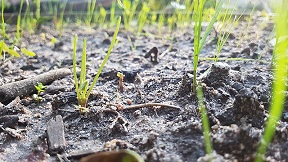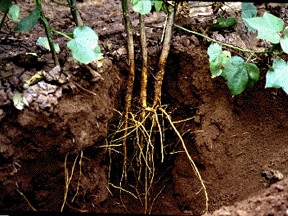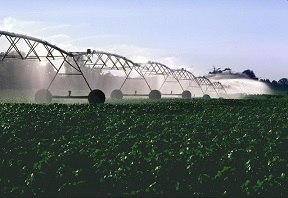George Monbiot published a new book, Regenesis: Feeding the World Without Devouring the Planet. He is the much acclaimed and (to some) controversial author who criticizes modern agricultural practices. In Regenesis, he develops a vision on what sustainable agriculture could look like. Quite different from present practices; requiring much attention to detail. But not necessarily less productive.

In a long article in The Guardian, Monbiot develops his view on the future of agricultural practices. He starts out describing the amazing complexity of the soil; that resource on which we all depend because it produces our food.. He looks upon the soil with the amazement of the child; of someone who discovers its bounty for the first time, although he has always known about its riches. But then, we don’t treat this bounty with much respect. And Monbiot tries to persuade us to change our view and start respecting nature (again).
Nature is full of little miracles
In order to do so, he confronts us with a number of miracles. The first of these is that the plant pumps food into the soil. Sugars, but also more complex chemicals. Food for microorganisms, in the so-called rhizosphere, the layer of soil immediately adjacent to the plant’s roots. Food not intended to promote bacterial growth in general, but specifically targeted to the limited number of soil organisms that help the plant grow and stay healthy. ‘When a plant root pushes into a lump of soil and starts releasing its messages, it triggers an explosion of activity. The microorganisms responding to its call consume the sugars the plant feeds them and proliferate to form some of the densest microbial communities on Earth…. they unlock the nutrients on which the plant depends and produce growth hormones and other chemicals that help it grow.’

So whereas we see just the plant, we witness in fact an entire community. Not unlike the community we are ourselves; as we likewise depend on myriads of bacteria that live in our guts. Bacteria that ‘educate our immune cells and send chemical messages that trigger our body’s defensive systems.’
Current agricultural practices
But then, Monbiot continues in well-documented passages, we don’t treat well the beneficial community beneath our feet. Much of the negative effects are due to our agricultural practices. Farming is responsible for about 80% of the deforestation that has happened this century, Monbiot writes. Of 28,000 species known to be at imminent risk of extinction, 24,000 are threatened by farming. And, he adds, ‘unless something changes, all this is likely to get worse – much worse.’ Already ‘half the calories farmers grow are now fed to livestock,’ and this proportion is growing. Our global agricultural practices may be unsustainable in themselves. They certainly are, combined with the climate change to come.

Take water supply, Monbiot argues. ‘The anticipated growth in crop yields would require 146% more fresh water than is used today. Just one problem: that water doesn’t exist.’ For if anywhere, then this is the field in which climate change will strike. Already, 4 billion people suffer from water scarcity for at least one month a year. Many major cities are threatened by extreme water stress. As groundwater is depleted, farmers have begun to rely more heavily on meltwater from glaciers and snowpacks. But these, too, are shrinking. The valley of the Indus is likely to suffer much, as the glaciers in the Himalaya are on retreat. And to this we can add the danger of soil degradation. A major threat to the global food system.
The alternatives
What then are alternative agricultural practices? Monbiot views as unpractical a ‘relocalisation and de-intensification of farming.’ Reducing the intensity of farming would mean the use of more land for the same population. And ‘the more land farming occupies, the less is available for forests and wetlands, savannahs and wild grasslands, and the greater is the loss of wildlife and the rate of extinction.’
Would eating less meat be the solution? After all, meat production has a very low productivity, counted in calories coming from a hectare. But here, Monbiot sees new technology coming to the rescue, in this case precision fermentation. This produces protein and fat from just microorganisms in the soil; fed on resources like water, hydrogen, CO2 and minerals. And agricultural produce, much more efficiently used than if we would allow cattle to graze. This has ‘the potential to replace all livestock farming, all soya farming and plenty of vegetable oil production, while massively reducing land use and other environmental impacts.’ If, he warns, we can resist possible patents filed by major corporations that would monopolize this source. ‘Ideally, this farm-free food should be open source.’
The importance of experiments
We would still need to produce cereals, roots, fruit and vegetables. This is where our new understanding of the soil will come in handy. Monbiot discusses two examples of farmers who succeeded in producing good yields from their land. Mainly by careful agricultural practices. In one farm in Kansas, USA, they grow perennial varieties of well-known crops: rice, wheat, oil crops and other grains. Perennials stay in the soil after the harvest and regrow the following year. The land isn’t lain bare, it holds water, the roots strengthen their relationships with bacteria that fix nitrogen from the air. Seems to be a viable alternative to annual crops.
The other example is from a farm in Oxfordshire, England. This farm differs from most in many respects. It started on land that was considered to be non-arable, because there were so many stones on the surface. The farmer grows 100 different vegetables. The crops are separated from each other by rows of untended banks where wildflowers grow, attracting insect predators that control pests. The farmer makes sure the land will never be bare. Beneath his vegetables grows an understorey of ‘green manure’, plants that cover the soil. The green manure ties up nutrients, fixes nitrogen, adds carbon and enhances the diversity of the soil. And on that layer, the farmer applies an average of one millimetre a year of chipped and composted wood. An inoculant that stimulates soil life – bacteria, fungi and what have you. All this adds up to a rich diversity in the rhizosphere, producing a fertile soil.
Conclusion
In short, this is wat Monbiot tells us. There is a wealth of productive agricultural practices to be discovered, on the basis of newly developed knowledge. Modern science in itself doesn’t produce the present practice of large-scale uniform agriculture; rather, this is being done by economic forces. With proper attention paid to the work, we might develop a very diverse agriculture. At the root of this lies attention to detail and careful tending of nature’s bounty.
In this view, there is an important perspective for agriculture. To produce the feedstock for food production through microorganisms. In the past, we devoted much attention on this site to such modern food production practices: precision fermentation, cultured meat, milk-free dairy etc.). All these productions use sugars or starch as their main energy and material source: potatoes, sugar beet, wheat. Sugars are ‘the mineral oil of the future’. Plants are our natural bounty; they transform sunlight, together with water and atmospheric CO2, to all our food. Either directly or indirectly, through sugars and microorganisms in precision fermentations. We can feed the world, not just in terms of calories and nutrients, but also in terms of a good relationship with nature and its riches. If we should just create proper incentives to do so.
Written together with Alle Bruggink
Interesting? Then also read:
Circular agriculture, the model of the future
Precision horticulture: what the consumer wants
Perspectives for agriculture – the new farming
